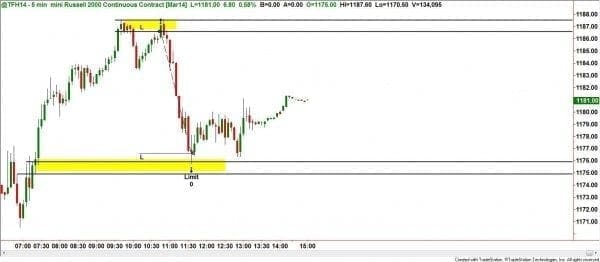One of the tenets of our supply and demand core strategy is buying low and selling high.? In its simplest form, this notion of buying low and selling high seems somewhat vague, as the most important part of this equation: the where to buy and where to sell piece is missing. If you?ve been reading these articles for any length of time, you know by now, that we buy at or near a demand zone, and do the selling at a supply zone.
Even knowing this information, it seems that when I talk to potential students, or communicate with readers of the Lessons from the Pros articles the biggest misconception about our strategy is that we are always looking to short a futures contract, stock, or Forex pair just because it has been rallying, or conversely, after a large drop we want to be buyers of any of the aforementioned asset classes.? There is a kernel of truth to this notion, however there has to be a quality demand level in order for us to push the buy button and a quality supply zone in order for a sell to occur.? ?Quality? is defined by a high score in the odds enhancer criteria used by our students. In addition, prices can fall substantially if there is little demand to arrest the selling, therefore, in this environment, we will continue to sell rallies into supply. ?Alternatively, in a rising market showing little real supply we will buy pullbacks into fresh demand zones.
Recently, some of the stock index futures traded to new all-time highs.? The E-mini S&P made its new high on February 24th followed by the Russell 200 on the 26th. ?In this situation the most common question is, since there is no supply when a market trades to a life-of -contract high can we short it?? The answer is yes, with the caveat that there has to be new supply is formed. In fact, these turn out to be great shorting opportunities as the last of the short sellers are capitulating and since most traders versed in conventional technical analysis are conditioned to buy when the markets make a new high they also jump in to join the bullish party. And yes, on occasion they will be rewarded as the short squeeze that ensues can propel the market higher, however, often times this turns out to be a trap as quite frequently those gains are quickly reversed in the short-term.? This is exactly what happened on the day the S&P carved out its new high.
On the day the E-mini Russell 2000 made its all-time high I was interested in shorting this contract because of the scenario I spelled out earlier, but I had to be patient since there was no supply on the charts.? I simply had to wait. I went for my normal workout in the morning and when I returned I noticed that about 10:00 am PST (I?m on the west coast) a supply level had formed. This was the opportunity I had been waiting for.? Once I drew out the supply level ( as seen on the chart below) I then placed a limit order at the lower line of the zone , a stop 2 ticks above the higher line and a ten point target as that was the next fresh demand.? As you can see by the chart the trade worked pretty much as planned capturing a very nice profit of ten points on the Emini Russell . Coincidentally, the risk versus reward on the trade was a smidge under ten-to -one, and the entry was a few ticks below the all-time high.
The key was to let the market form a supply zone, thus, presenting us with a very low risk entry, so that if we?re wrong (which will happen sometimes), we would ?lose very little. ?The low risk, along with the fact the profit margin was terrific made it a great opportunity.
In the final analysis, it?s fine to short new highs as long as the sellers show their hand and the profit potential is commensurate with the risk.? And yes, I know, according to all the trading books ever written about trading the trade I took is a big no-no because you can?t ever pick tops, ?but where else would ?I find the lowest risk entry.
Until next time, I hope everyone has a great week.

